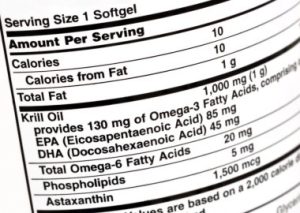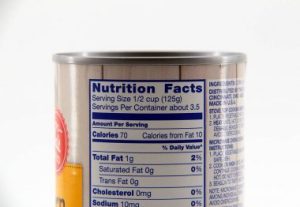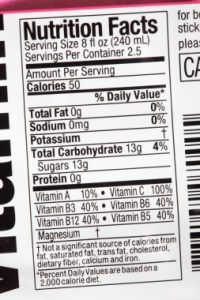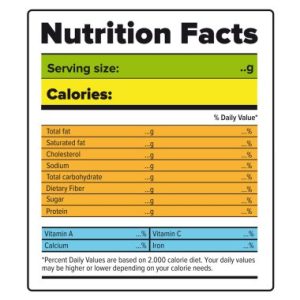
How To Read A Nutrition Facts Label (5 Helpful Guidelines)
How to read a Nutrition Facts label? Transforming nutritional jargon into a roadmap for healthier choices. Unlocking the secrets to a healthier lifestyle begins with understanding the language of nutrition, and there’s no better guide than the Nutrition Facts label. Like a roadmap for your well-being, this small but mighty chart holds the key to making informed choices about the food you consume.
From deciphering serving sizes to navigating the intricacies of macronutrients, diving into the world of Nutrition Facts labels empowers you to take control of your diet and pave the way to a nourished and vibrant life. Let’s embark on a journey to unravel the mysteries behind the numbers and letters that shape your daily nutrition, as you decode the art of reading a nutrition facts label.
The nutritional label on any packaged food is like a treasure map, revealing the secret coordinates of sustenance. Nestled amidst the labyrinth of information, the macronutrients reign supreme, each proudly staking its claim to the food’s fortification.

How To Read A Nutrition Facts Label
Reading a Nutrition Facts label involves a systematic examination of key information. Start by checking the serving size to understand portion proportions. Identify the total calories per serving and assess the macronutrients, such as fat, carbohydrates, and protein. Keep an eye on added sugars and take note of the percentage of daily values provided. Scan for essential nutrients like vitamins and minerals, and be mindful of the ingredient list for potential allergens or additives. Armed with this knowledge, you can make informed decisions about your dietary choices, promoting a healthier lifestyle.
Where Are Macronutrients Located On Nutritional Label
Unlocking the secrets to a healthier lifestyle begins with understanding the language of nutrition, and there’s no better guide than the Nutrition Facts label. Like a roadmap for your well-being, this small but mighty chart holds the key to making informed choices about the food you consume. From deciphering serving sizes to navigating the intricacies of macronutrients, diving into the world of Nutrition Facts labels empowers you to take control of your diet and pave the way to a nourished and vibrant life. Let’s embark on a journey to unravel the mysteries behind the numbers and letters that shape our daily nutrition, as we decode the art of reading a nutrition facts label.
On a nutritional label, macronutrients are typically located under the “Nutrition Facts” section, which is a prominent part of packaged food products. This section includes information about the three main macronutrients: carbohydrates, proteins, and fats.
Understanding Macronutrients on a Nutritional Label
When you examine a nutritional label, you’ll find essential information about the macronutrients, which are the fundamental nutrients your body needs in large quantities for energy and overall well-being. These macronutrients are categorized into three primary groups: carbohydrates, proteins, and fats.
Carbohydrates – Fuel for Energy
Carbohydrates, a fundamental macronutrient, play a crucial role in providing energy for the body. On a nutritional label, the carbohydrate section typically includes two main components: total carbohydrates and dietary fiber. Total carbohydrates encompass sugars, starches, and fiber, giving consumers a comprehensive overview of the various forms of carbohydrates present in the product.
Monitoring carbohydrate intake is vital for those managing blood sugar levels or following specific dietary plans. Additionally, the inclusion of dietary fiber information aids individuals in making choices that promote digestive health and sustained energy release. Paying attention to the carbohydrate content on nutritional labels is key to maintaining a balanced and health-conscious diet.
Proteins – Building Blocks of Life
Proteins, often referred to as the building blocks of life, play a crucial role in the nutritional landscape showcased on food labels. Represented prominently alongside other macronutrients, proteins are essential components that contribute to the structure and function of cells, tissues, and organs within the human body.
Displayed in grams, the protein content on nutritional labels informs consumers about the quantity of amino acids, the fundamental building units of proteins, present in a serving size. Recognizing the importance of proteins in supporting growth, repair, and overall bodily functions empowers individuals to make informed dietary choices in pursuit of a balanced and healthful lifestyle.
Fats – Essential for Health
Fats play a crucial role in the nutritional landscape, and their presence on a nutritional label provides valuable insights into the composition of a food product. On the nutritional label, fats are often categorized into different types, including saturated fats, unsaturated fats, and trans fats.
Saturated fats, found in various animal products and some plant oils, are generally considered less healthful in excess. Unsaturated fats, on the other hand, are often sourced from plants and can be heart-healthy when consumed in moderation. Trans fats, though increasingly minimized in processed foods, may still be present and are typically associated with heightened health risks.
The total fat content listed on the label gives an overview of the combined amount of these fats, aiding consumers in making informed choices about their dietary fat intake. Understanding the role of fats in a nutritional context is vital for maintaining a balanced and healthy diet
Total Macronutrients
Total Macronutrients Unveiled
The nutrition label is a treasure trove of essential information, beginning with the serving size and servings per container. At the forefront stand the macronutrients, pivotal in understanding a food’s composition. The total macronutrients unveiled in a nutritional label serve as a fundamental guide for individuals seeking a comprehensive understanding of the nutritional content within a food product.
These macronutrients, prominently displayed as grams per serving, encompass carbohydrates, proteins, and fats—the three primary components that contribute to the caloric value of the food. Carbohydrates, including sugars and dietary fiber, provide a source of energy, while proteins are crucial for muscle development, repair, and overall body function. Fats, both saturated and unsaturated, contribute to energy storage and play vital roles in various physiological processes.
The total macronutrient breakdown empowers consumers to make informed choices aligned with their dietary goals, whether it be managing caloric intake, optimizing protein consumption, or balancing macronutrient ratios for a healthy lifestyle.
Breakdown of Macronutrients
A nutritional label provides essential information about the core breakdown of macronutrients, offering valuable insights into the composition of a food product. The three main macronutrients are carbohydrates, proteins, and fats. Carbohydrates are a primary energy source, providing 4 calories per gram. Carbohydrates, encompassing Dietary Fiber (aim for 25-30 grams per day), Sugars (both natural and added, limited intake advised), and Sugar Alcohols, if present.
Proteins, crucial for muscle repair and maintenance, also contribute 4 calories per gram. Fats, playing a role in energy storage and nutrient absorption, are the most calorie-dense macronutrient, offering 9 calories per gram. Fats, often include Saturated Fats (not to exceed 10% of daily calories), Trans Fats (best avoided), and the healthier Monounsaturated and Polyunsaturated Fats.
A typical nutritional label details the quantity of each macronutrient present in a serving size, allowing consumers to make informed dietary choices. By understanding the daily caloric intake from these macronutrients, individuals can better manage their energy balance and maintain a healthy lifestyle.
Serving Size
Understanding the serving size specified on a Nutrition Facts label is a fundamental aspect of making informed dietary choices. Serving size not only dictates the quantity of food the nutritional information applies to but also serves as a reference point for calorie and nutrient content.
It is crucial to note that the serving size listed may not necessarily reflect typical portion sizes but is rather a standardized measure established by the food industry. Consumers often overlook this key detail, leading to miscalculations in nutrient intake. By paying close attention to the serving size, individuals can accurately assess the nutritional value of the food they consume and make adjustments to meet their specific dietary needs.
Whether aiming to manage calorie intake, track nutrient consumption, or compare similar products, a clear understanding of serving size empowers individuals to take control of their nutritional choices and work towards a balanced and health-conscious diet.

Total Calories Per Serving And Container
The total calories per serving and container, highlighted on the Nutrition Facts label, serve as a pivotal starting point for understanding the energy content of a food product. The “calories per serving” information provides a snapshot of the energy that one serving contributes to your daily intake, facilitating mindful portion control.
This figure is particularly crucial for those focused on weight management or specific caloric targets. Additionally, the “calories per container” aspect extends this awareness to the entire package, offering transparency for individuals consuming the entire product or considering multiple servings. Whether you’re monitoring your daily caloric intake or comparing similar products, this information empowers consumers to make informed choices aligned with their dietary goals and overall health objectives.

% Daily Value (%DV)
The Percentage Daily Value (%DV) is a crucial component of a nutritional label, providing consumers with a quick and easy way to assess the nutritional content of a food item in relation to their daily dietary needs. Typically based on a daily intake of 2,000 calories, the %DV indicates the proportion of key nutrients such as fats, carbohydrates, proteins, vitamins, and minerals contained in a single serving of the product.
A value of 5% or less is considered low, while 20% or more is considered high. This information empowers consumers to make informed choices about their diet by quickly gauging whether a particular food item contributes significantly to their daily nutrient requirements. It serves as a helpful tool for maintaining a balanced and healthy diet, assisting individuals in making informed decisions about their overall nutritional intake.

Footnotes or Additional Information
In writing, footnotes serve as treasure troves of additional information, shedding light on ambiguous points or expanding on critical details that might get lost in the main text. From clarifying recommended daily values to providing essential context, footnotes offer a deeper understanding for those inquisitive minds seeking precise dietary guidance.
In nutritional guides, footnotes clarify the recommended daily values for a 2000 or 2500-calorie diet, enhancing comprehension for those striving for a balanced and healthy lifestyle. These small annotations, often nestled at the bottom of a page, carry the weight of essential information, acting as signposts for curious readers. Whether it’s delving into the nuances of calorie intake or understanding the subtleties of dietary needs, footnotes serve as beacons of clarity in a sea of information.
Footnotes on nutritional labels play a crucial role in providing additional information, especially concerning special populations with unique dietary needs. These footnotes often specify details related to recommended daily values based on a standard 2,000-calorie diet, which may not be applicable to everyone, particularly those in special populations such as pregnant women, lactating mothers, infants, elderly individuals, and individuals with specific medical conditions.
For instance, footnotes may highlight the increased need for certain nutrients like folic acid during pregnancy or the importance of calcium intake for postmenopausal women to support bone health. Additionally, footnotes may caution individuals with conditions like diabetes about monitoring carbohydrate intake. By including specific information in footnotes, nutritional labels aim to guide individuals in special populations toward making informed and personalized dietary choices to meet their unique nutritional requirements.
Understanding the significance of footnotes in deciphering dietary jargon or grasping the intricacies of healthy living is crucial for making informed choices. They bridge the gap between the general information provided and the specific details necessary for tailored decisions. Unlock the potential of footnotes to empower your dietary choices and navigate the labyrinth of nutritional information with confidence.

Other Locations
In addition to the familiar “Nutrition Facts” panel found on most food packaging, there are other crucial locations on a nutritional label that provide valuable information for consumers. One such area is the ingredient list, typically located near the Nutrition Facts. Here, ingredients are listed in descending order by weight, allowing consumers to discern the primary components of the product.
This section is vital for individuals with specific dietary restrictions or allergies, enabling them to make informed choices. Furthermore, certain labels may include a separate section for allergen information, emphasizing the presence of common allergens like nuts, dairy, or gluten.
Additionally, some labels provide a “Percent Daily Value” (%DV) column next to each nutrient in the Nutrition Facts, aiding consumers in understanding how a particular food contributes to their daily nutritional needs based on a standard 2,000-calorie diet. These various locations collectively empower consumers to make informed and health-conscious decisions about the food they consume.

Why nutritional labels are so confusing
Nutritional labels can be bewildering for consumers due to a myriad of factors that contribute to their complexity. One significant challenge lies in the use of scientific terminology and unfamiliar jargon that can make it difficult for the average person to decipher the true nutritional content of a product. Serving sizes can also be misleading, as they may not align with realistic consumption patterns, leading to misunderstandings about the actual nutritional intake.
Moreover, the variation in recommended daily values across different countries or regions adds to the confusion, making it challenging for consumers to make accurate comparisons between products. The presence of numerous ingredients, some with unfamiliar names or codes, further complicates matters, leaving consumers grappling with uncertainty about the overall health implications of their food choices. As a result, efforts to enhance the clarity and transparency of nutritional labels are essential to empower individuals to make informed and healthier dietary decisions.
Nutrition facts label variations
Nutrition fact label variation refers to the differences and inconsistencies that may exist among the nutritional information displayed on food packaging. These labels are designed to provide consumers with vital details about the content of a product, including serving size, calories, and nutrient composition. However, variations can arise due to factors such as different serving sizes used by manufacturers, variations in ingredients, or discrepancies in the accuracy of testing methods.
In some instances, these discrepancies can lead to confusion among consumers trying to make informed dietary choices. Standardizing and regulating nutrition fact labels is crucial to ensure transparency and accuracy, empowering individuals to make healthier choices and facilitating a more uniform understanding of the nutritional content of various food products.
Duel column labels
Dual column labels for products larger than single servings play a crucial role in providing comprehensive nutritional information to consumers. Unlike single-serving products that may list nutrition facts for the entire package, dual column labels are designed to offer both per-serving and per-package details.
This format enables consumers to make more informed decisions based on their specific dietary needs and serving sizes. Whether it’s a family-sized snack or a multi-serving meal, these labels help individuals better understand the nutritional content of each portion, fostering transparency and promoting healthier choices.
Additionally, dual column labels cater to diverse consumer preferences, acknowledging that some may consume the entire package in one sitting while others may choose to portion it out over multiple servings. This approach enhances the overall consumer experience by accommodating a range of dietary habits and facilitating more informed and conscious food choices.
Single ingredient sugar label
A single-ingredient sugar label featuring honey or maple syrup is a straightforward declaration of the pure and natural sweetness derived from these distinct sources. When you encounter such a label, it signifies a product that contains only one primary sweetening component – either honey or maple syrup – without any additional additives or refined sugars.
This simplicity reflects a commitment to providing consumers with a more wholesome and unadulterated sweetening experience. Honey, with its rich floral notes, or maple syrup, with its distinctively robust and caramel-like flavor, not only contribute sweetness but also bring unique and nuanced taste profiles to the product.
Moreover, the transparency of a single-ingredient label empowers consumers who seek authenticity in their food choices, allowing them to make informed decisions about the source and purity of the sweeteners they choose to incorporate into their diets.
Frequently Asked Questions About How To Read A Nutrition Facts Label
Q What information is typically found on a Nutrition Facts label?
A The Nutrition Facts label provides details on serving size, calories, and various nutrients such as fat, cholesterol, sodium, carbohydrates, fiber, sugars, and protein.
Q How do I interpret the serving size on the Nutrition Facts label?
A The serving size indicates the amount of food typically consumed at one time. Understanding this is crucial for accurate nutrient intake assessment.
Q Why is it important to pay attention to calories on the Nutrition Facts label?
A Calories represent the energy content of a serving. Monitoring calorie intake is essential for weight management and overall health.
Q What are the different types of fats listed on the Nutrition Facts label, and why does it matter?
A The label distinguishes between saturated fats, trans fats, and unsaturated fats. Differentiating these fats helps make healthier choices for heart health.
Q How can I identify added sugars on the Nutrition Facts label?
A Look for “Sugars” on the label, and also check the ingredients list for terms like sucrose, high-fructose corn syrup, and other sweeteners.
Q What role does % Daily Value (%DV) play on the Nutrition Facts label?
A %DV indicates how much a nutrient in a serving contributes to a daily diet. It’s a quick way to assess if a food is high or low in a particular nutrient.
Q How do I use the Nutrition Facts label for dietary considerations, such as managing sodium intake?
A The label provides information on sodium content per serving, helping individuals monitor and control their salt intake, which is important for heart health.
Q Why is fiber important, and how can I ensure I’m getting enough based on the Nutrition Facts label?
A Adequate fiber intake supports digestive health. Look for foods high in dietary fiber and aim to meet the recommended daily intake.
Q Are all nutrients on the Nutrition Facts label equally important?
A No, the significance of nutrients varies based on individual health goals. Prioritize nutrients that align with your dietary needs, such as fiber, vitamins, and minerals.
Q How can I use the Nutrition Facts label to compare similar products?
A By comparing calories, serving sizes, and nutrient content, you can make informed choices and select products that align with your nutritional goals.
conclusion
In conclusion, mastering the skill of reading a nutrition facts label is not just about understanding numbers and percentages; it’s about taking charge of your well-being. This small but mighty label serves as your compass, guiding you through the nutritional landscape and helping you make choices that align with your health goals.
As you become adept at interpreting serving sizes, identifying essential nutrients, and distinguishing between hidden ingredients, you empower yourself to make informed decisions that can positively impact your overall health. Remember, the journey to a healthier lifestyle is paved with knowledge, and the nutrition facts label is your trusted companion on this path.
Armed with this newfound understanding, you are equipped to navigate the aisles of the grocery store with confidence, making choices that nourish not only your body but also your vitality and longevity. So, embrace the wisdom within the label, and let it be your ally in the pursuit of a healthier, happier you.